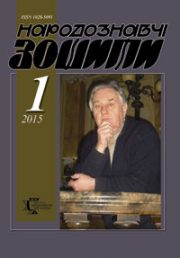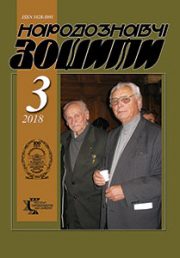The Ethnology Notebooks. 2019, № 3 (147), 622—640
UDK 398.332.1/.2:58(=161.2:477:292.452)
DOI https://doi.org/10.15407/nz2019.03.622
GOSHCHYTSKA Tеtyana
ORCID ID: https://orcid.org/0000-0001-8596-8974
Candidate of historical sciences / Doctor of Philosophy,
Researcher fellow of department of Historical Ethnology
of the Institute of Ethnology
The National Academy of Sciences of Ukraine,
15, Svobody Avenue, 79000, Lviv, Ukraine
Contacts: Е-mail: hoshchitska.tetiana@gmail.com
Abstract. Introduction: The article deals with the mythology of the world tree in world mythologies and monuments of the Ukrainian Carpathians traditional culture. Problem Statement: we can assert that the image of the world tree is universal, archetypal and in one form or another is fixed in ideological representations of people all over the world. The structure of the world tree almost everywhere has a clearly delimited three-tier structure, in which you can distinguish three main areas of being development: the beginning or the lower sphere, identified with the roots; the middle, identified with the trunk; the ending presented by the crown. Each of these tree spheres is the repository of certain characters and images of the living world. The purpose of the article is to systematize and analyze data on the mifologems of world tree and the beliefs associated with them in the traditional culture of the Ukrainian Carpathians. Methods: The main methods involved in the article are structural, comparative and analytical. In the process of research, we used an interdisciplinary method and involved archeology, ethnology, art studies, religious studies and petroglyphistics materials.
Conclusion: All these beliefs are somehow reflected in mythological representations, folklore, rituals, various household objects and clothes of different people around the world. Thus, according to the analyzed sources, the archetypal image of the world tree is traced back to the late Paleolithic monuments of Ukraine. In this regard Ukrainian Carpathians region, and Ukraine in general, are not exceptions. We can see the constant presence of this motive in rituals and everyday life of people. In particular, we have followed this motive in many ways (from very conditioned images and to the reproduction of complex mythological stories of Carpathian Easter eggs) on the monuments of decorative and applied arts, which, despite considerable local flavor, clearly correlate with the monuments of plain terrains. In this context, another significant feature of the world tree image attracts attention — its correlation with human. This, on the one hand, manifested itself in folk art (for example, the image of anthropomorphic trees on towels “rushnyk”), and on the other hand in traditional beliefs, where trees in general were correlated with a human (they had age, gender, had to die «by its own death», could be a counterpart of living person, even more, according to some Carpathian legends, individual families carried their genealogy from a certain tree). Therefore, it is advisable (apart from the cosmogonic motive, symbolism of fertility, the embodiment of the idea of constant revival and eternal life) to distinguish the anthropomorphic motive of the world tree, when it can be correlated to a person in its interaction with surrounding world.
Keywords: tree symbol, mythologies, traditional ritualism, spring-summer cycle, Ukrainian Carpathians, beliefs, cult of vegetation.
Received 8.04.2019
REFERENCES
Toporov, V.N. (2010). World Tree. Universal sign complexes (Vol. 1). Моscow [in Russian].
Kytova, S. (2003). Fabricated Chronicle of Ukraine: Semantics of the Ukrainian Towel. Cherkasy [in Ukrainian].
Skoryk, M. (1934). Boykivsky pysanky. In Litopys Bojkivschyny: zapysky prysviacheni doslidam istorii, kul’tury i pobutu bojkivs’koho plemeni (Vol. IV, part 4, pp. 20—28) [in Ukrainian].
Zakharchuk-Chuhaj, R. (2006). Еmbroidery. In Ethnogenesis and ethnic history of the Ukrainian Carpathians (Vol. 2, pp. 649—667). Lviv: In-tut narodoznavstva NANU [in Ukrainian].
Horbal’, M., & Liashenko, O. (2002). Pysanky. In Lemkivschyna (Vol. 2, pp. 317—330). Lviv: In-tut narodoznavstva NANU [in Ukrainian].
Liashenko, O. (1987). Pysanky. In: Hutsul’schyna (pp. 422—430). Кyiv: Naukova dymka [in Ukrainian].
Fedyna, O. (2006). The Tree of life as an image of Ensemble of Ukrainian Traditional Folk Costume at ХІХ and early ХХ сc. In Naukovyj visnyk. Natsional’nyj lisotekhnichnyj Universytet. (Vol. 16.4, pp. 149—152) [in Ukrainian].
Stankevych, M. (2006). Ukrainian artistic tree. In Ethnogenesis and ethnic history of the Ukrainian Carpathians (Vol. 2, pp. 709—726). Lviv: In-tut narodoznavstva NANU [in Ukrainian].
Koshovyj, O. (2002). Ceramics. In Lemkivschyna (Vol. 2, pp. 330—338). Lviv: In-tut narodoznavstva NANU [in Ukrainian].
Koshovyj, O. (2006). Ceramics. In Ethnogenesis and ethnic history of the Ukrainian Carpathians (Vol. 2, pp. 766—788). Lviv: In-tut narodoznavstva NANU [in Ukrainian].
Kolupayeva, A. (2006). Ukrainian tiles XIV — early XX centuries. History. Typology. Iconography. Ambivalence. Lviv [in Ukrainian].
Ivachniuk, I. (2011). The genezation of Hutsul candlesticks in the context of animistic representations. In: Topical Folk: Interpretations of Traditional Culture. Proceedings of the 7th Honchar Readings Conference (pp. 260—269). Кyiv [in Ukrainian].
Solomchenko, O.H. (2002). Priests of the Ukrainian Carpathians. Uzhhorod [in Ukrainian].
Diadiukh-Bohat’ko, N.J. (2018). The art of decorating weapons in Hutsulshchyna in the XVIII—XIX centuries. Lviv: Lviv Polytechnic University Publishing House [in Ukrainian].
Кyryliyk, О.V. (2006). Universal cultural senses of symbol of World Tree. In: Scientific Herald National Forestry University. (Vol. 16.4, pp. 72—79). Lviv [in Ukrainian].
Avdiyev, V.I. (1948). The history of the ancient East. Моscow [in Russian].
Brahynskyj, Y.H., & Lelekov, L.A. (1980). Iranian Mythology. In Myths of the world: Encyclopedia (Vol. 1 (А—К), pp. 560—565) Моscow [in Russian].
Shaposhnykova, L.V. (1968). Jungle roads. Моscow: Mysl’ [in Russian].
Ermyn, V.H. (1980). Hindu mythology. In The myths of the world: Encyclopedia (Vol. 1 (А—К), pp. 535—542). Моscow [in Russian].
Yanshyna, E.M. (1984). Formation and development of ancient Chinese mythology. Моscow: Nauka [in Russian].
Salevych, P. (2000). «Mis» and the world tree in «The Word of the Igor’s Regiment». The Ethnology Notebooks, 2, 655—659 [in Ukrainian].
Kendell, E. (2005). The Incas. Life, religion, culture. Моscow [in Russian].
Takazov, F.M. (2014). Mythological archetypes of the world model in the Ossetian cosmogony. Vladykavkaz [in Russian].
Toporov, V.N. (1980). World Treе. In The myths of the world: Encyclopedia (Vol. 1 (А—К), pp. 398—406). Моscow [in Russian].
Lyps, Yu. (1954). The origin of things: from the history of human culture. Моscow: izdatel’stvo inostrannoj lyteratury [in Russian].
Kyrchiv, R. (2002) Oral folk art of boiks. In From the folklore regions of Ukraine. Essays and articles (pp. 34—114). Lviv: In-tut narodoznavstva NANU [in Ukrainian].
Yurkevych, Yu. (2008). Hutsul and Pokut candlesticks-three. Lviv [in Ukrainian].
Larychev, V.E. (1980). Al’tamyra — the tragedy and grandeur of the discovery of Don Marcelino S. De Sautuola (To the centenary of the study of cave art). In: Animals in stone. (pp. 8—35). Novosybyrsk: Nauka [in Russian].
Semenov, V.A. (2008). Primitive art: Stone Age. Bronze age. Sankt-Peterburh: Azbuka-klassyka [in Russian].
Frejd, Z. (2003). Introduction to psychoanalysis. Lectures. Моscow [in Russian].
Nesen, I. (2007). The wedding ritual of Central Polissya: the traditional structure and relic forms (mid-19th—20th centuries). Кyiv: Naukova dymka [in Ukrainian].
Yunh, K. (2010). Libido, its metamorphosis and symbols. Sankt-Peterburh [in Russian].
Pyotrovskyj, B.B. (1962). Art of Urartu 8—6. at. BC e. Leningrad: іzdatel’stvo hosudarstvennoho Ermytazha [in Russian].
Archeology of the Ukrainian SSR in three volumes (1971). Primeral archeology (Vol. 1). Kyiv [in Ukrainian].
Vereschahyn, N.K. (1981). Notes by the paleontologist. Моscow: Nauka [in Russian].
Okhrimenko, H., & Stril’chuk, H. (1998). Ancient images of the kusta (kuscha). In: History of Religions in Ukraine. Scientific Yearbook (Vol. 1. pp. 172—173). Lviv: Lviv Museum of the History of Religion, Logos [in Ukrainian].
Rybakov, B.A. (1994). Paganism of ancient Slavs. Моscow: Nauka [in Russian].
Tkachuk, T.M., & Mel’nyk, Ya.H. (2005). Semiotic analysis of Trypilly-Kukten sign systems (dishware) (Vol. ІІ). Vinnytsia [in Ukrainian]
Diadenko, V. (1962). A unique monument of ancient art. Folk art and ethnography, 4. 142—145 [in Ukrainian].
Bessonova, S.S. (1983). Religious representations of the Scythians. Кyiv: Naukova dymka [in Russian].
Nasardynova, A.M. (2001). Architectural and typological classification of kurgan institutions of the nomadic world. Retrieved from: http://journals.manas.edu.kg/mjsr/oldarchives/Vol05_Issue09_2004/343.pdf (Last accessed: 02.04.2019) [in Russian].
Bandrivs’kyj, M.S. (1992). Settlement of the Early Bronze Period in the tract «Lazni» near Vynnyk. In: Археологічні дослідження Винниківського краєзнавчого музею за 1991 рік. (pp. 15—38). Vynnyky [in Ukrainian].
Siletsky, R. (2012—2013). Ukrainian Traditional Ritual requirements for felling Trees. In: Proceedings of History Faculty of Lviv University (Vol. 13—14, pp. 116—127) [in Ukrainian].
Frezer, Dzh. (1986). Golden branch: a study of magic and religion. Моscow [in Russian].
Latynyn, B.A. (1933). The world tree is the tree of life in the ornament and folklore of Eastern Europe. On the issue of remnants. Lenynhrad [in Russian].
Rusanova, Y.P., & Tymoschuk, B.A. (1993). Pagan shrines of the ancient Slavs. Моscow [in Russian].
Ahapkyna, T.A. (2002). Tree iconic. Slavic mythology: Encyclopedic dictionary. (рр. 134—136). Моscow [in Russian].
Vereschahyn, N.K. (1981). Notes of the paleontologist. Моscow: Nauka [in Russian].
Shapovalov, H. (1997). Ships of faith. Navigation in the spiritual life of ancient Ukraine. Zaporozh’e [in Russian].
Zabashta, R.V., & Poshyvajlo, O.M. (1992). «Peruvian oaks». Archeology, 2, 57—69 [in Ukrainian].
Kozak, D.N. (1990) Shrines of the Eastern Slavs. In: Rites and beliefs of the ancient population of Ukraine. Collection of scientific papers. (pp. 84—100) Кyiv: Naukova dymka [in Russian].
Tul’tseva, L.A. (1976). Rowan in popular beliefs. Soviet ethnography, 5, 88—99 [in Russian].
Tokarev, S.A., & Fylymonova, T.D. (1983). Rites and customs associated with vegetation. In Calendar customs and ceremonies in countries of foreign Europe. Historical roots and development of customs (pp. 145—160). Моscow: Nauka [in Russian].
Mohytych, R. (1998). Sacred oak in old Lviv. In: The History of Religions in Ukraine Naukovy Schorichnik (Vol. 1, pp. 150—153) Lviv: L’vivs’kyj muzej istorii relihii, Lohos [in Ukrainian].
Kobil’nyk, V. (1934). MISCELLANEA. In: Litopys Bojkivschyny: zapysky prysviacheni doslidam istorii, kul’tury i pobutu bojkivs’koho plemeni (Vol. IV, part 3, pp. 120—121) [in Ukrainian].
Tajlor, E. (1939). Primitive culture. Моscow [in Russian].
Tuholukov, V.A. (1969). Pathfinders riding deer. Моscow: Nauka [in Russian].
Zborovs’kyj, P. (2015). Legends, tricks and tales from Turkovshchyna. Lviv [in Ukrainian].
Kachmar, M. (2010) Structural-semantic peculiarity of Ukrainian etiological legends with dendrological motives. Mythology and folklore, 2, 122—129 [in Ukrainian].
Moszynski, K. (1929). Folk culture of Slavs (Vol. 2). Krakow [in Polish].
The king-tree. Village Vezhitsa. Retrieved from: https://www.youtube.com/watch?v=yIjhk1WhxIc (Last accessed: 02.04.2019) [in Ukrainian].
Іvashkiv, H.(2007). The Dйcor of Ukrainian folk ceramics of the 16-th — first Half of the ХХ сc. Lviv: In-tut narodoznavstva NANU [in Ukrainian].
Zakharchuk-Chuhaj, R.V. (1988). Ukrainian folk embroidery. Western regions of the Ukrainian SSR. Кyiv: Naukova dymka [in Ukrainian].
Zakharchuk-Chuhaj, R.V. (2002). Embroidery. In Lemkivschyna (Vol. 2, pp. 256—273). Lviv: In-tut narodoznavstva NANU [in Ukrainian].
Aronets’, M.M. (1974). Folk embroidery of the Precarpathians of the late 19th and early 20th centuries. In Ukrainian art (Vol. 6, pp. 95—104) Кyiv: Naukova dymka [in Ukrainian].
Nykorak, O. (2002). Artistic textile. In Lemkivschyna (Vol. 2, pp. 242—255). Lviv: In-tut narodoznavstva NANU [in Ukrainian].
Sydorovych, S. (1979). Artistic textile of the western regions of the Ukrainian SSR. Кyiv: Naukova dymka [in Ukrainian].
Mozdyr, M.I. (1987). Carving. In: Hutsul’schyna. (pp. 388—404). Кyiv: Naukova dymka [in Ukrainian].
Shukhevych, V. (1908). Hutsul’schyna. In Materialy z ukrains’korus’koi etnolohii (Vol. VII, pp. 1—272) [in Ukrainian].
Zubryts’kyj, M. (1900). Country homes at Mshantsy, Starosambirs’koho povitu. In: Materialy do ukrainskoi etnolohii (Vol. XI, pp. 1—22) [in Ukrainian].
Dubyna, R. (2011). New Year’s cycle of holidays of the folk calendar of the Eastern Boykivshchyna.In: Sources to Ukrainian Ethnology: materials of field research. (pp. 131—137) Кyiv [in Ukrainian].
Kyrchiv, R. (2002) Regionalization of the folklore tradition. In From the folklore regions of Ukraine. Essays and articles (pp. 7—33). Lviv: In-tut narodoznavstva NANU [in Ukrainian].
Tarnovych, Yu. (1941). Lemkivschyna. Material culture. Krakow [in Ukrainian].
Pavleshyn, A. (2009). Lypovnians’ki pysanky. Zahreb [in Ukrainian].







